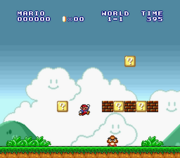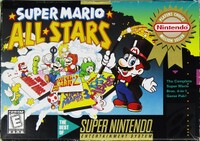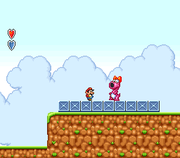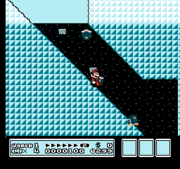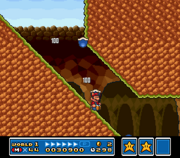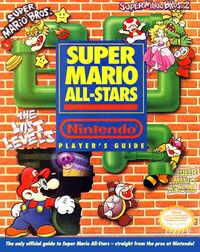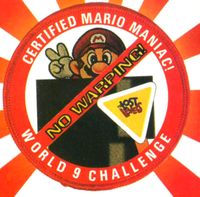Super Mario All-Stars
- This article is about the SNES game. For other uses, see Super Mario All-Stars (disambiguation).
Super Mario All-Stars (also known as Super Mario Collection in Japan), is a compilation of remakes for the Super Nintendo Entertainment System (the Super Famicom in Japan). It ports Super Mario Bros., Super Mario Bros. 2, Super Mario Bros. 3 and Super Mario Bros.: The Lost Levels (known as Super Mario Bros. 2 For Super Players in Japan) to the Super Nintendo with an added on-cartridge save feature, updated graphics and sound, and an additional "battle game" for Super Mario Bros. 3. It is also the first time that Super Mario Bros.: The Lost Levels was released for the western public.
This game was re-released again as Super Mario All-Stars + Super Mario World, which as the title suggests, additionally featured Super Mario World with updated graphics. Unlike the original, It was never released in Japan.
During development, the Japanese developers called this game "Mario Extravaganza".
In 2010, the game was re-released on the Wii as part of the Super Mario Bros. 25th anniversary, under the title Super Mario All-Stars Limited Edition. The game was initially released with a Mario history booklet and a CD containing songs and sound effects from various games.
Differences and changes
Changes to Super Mario Bros. and Super Mario Bros.: The Lost Levels
Graphics
There are graphical enhancements for all settings. Grassland levels have grass on the ground (The ground is no longer made of blocks). All levels have backgrounds (for example, levels that take place at night have a twinkling star background). Worlds 3, 5, and 7 makes their being in a setting covered in snow more clear by adding snow to the ground, as originally, it was only implied to be covered in snow due to the bushes being white (this does not affect gameplay). Underground levels show a wall in the background. Underwater levels have a distortion effect. Many levels that had snow in the original Japanese Super Mario Bros. 2 do not have it in the Lost Levels edition, including Worlds 3-3, 7-1, 7-2, 7-3, 8-1, C-3, D-1, D-2, and D-3. Snow was introduced into World C-1, although it is only an aesthetic difference. Green Koopa Troopas are always green (as opposed to being teal in underground levels.) The color of Bloopers was changed from white to pink, and gray Cheep Cheeps are now green. Bullet Bills' arms are now animated, and Bowser now resembles his Super Mario Bros. 3 design. Worlds 6-3 in the first game and 7-3 and C-3 in The Lost Levels are now depicted as having the same color standard as in Worlds 3-3 and 2-3, respectively, as originally, they were completely monochrome. There are parallax scrolling layers in the background. Secret underground levels have a picture of Mario or Luigi showing a V sign in the background, which are labeled "Bonus". This is also seen in Coin Heaven. Underground levels like World 1-2 place an echo effect on all sounds. Lava is no longer just recolor of water and is boiling. Super Mario Bros. and Super Mario Bros.: The Lost Levels do not have the same graphics as each other to begin with. For instance, the ground is covered by blocks in most of the levels of the original, whereas the ground is mainly covered by dirt in this version. In Super Mario All-Stars, the graphics of all the games were improved, and Super Mario Bros.: The Lost Levels was made to look exactly the same as the graphically-improved version of Super Mario Bros. released on the same cartridge. World 9's graphics were made to look exactly the same as the graphics within the rest of the worlds, unlike the deliberately glitch-like appearance from the original game.
Luigi is now no longer a simple recolor of Mario, the Bros.' standing pose is different and now resembles his design from Super Mario Bros. 3, but with the shirt and overall colors swapped and recolored, and Fire Mario and Fire Luigi are no longer colored the same having the shirt/overall colors swapped (Mario got a blue shirt and red overalls (similar to Mario's outfit from the DIC cartoons) while Fire Mario got a red shirt and white overalls (similar to Super Mario's outfit from the DIC cartoons), and Luigi got a purple shirt and green overalls (similar to Luigi's outfit from the DIC cartoons) while Fire Luigi got a green shirt and white overalls (similar to Super Luigi's outfit from the DIC cartoons)). When a brother enters a bigger castle, he takes the middle door rather than the left one. Before vanishing in a door, he shows a V sign with his fingers. The Bros. also show a V sign when entering a pipe from above.
As opposed to simply standing on the ground, Toads are now found in sacks, which they somehow escape from after Mario or Luigi come. Also, rather than rescuing a single Toad in every castle, the player rescues multiple Toads based on the world they are in (two Toads in World 2, three Toads in World 3, and so on). They always have a different animation when Mario rescues them from a sack. The final scene where Mario rescues Princess Toadstool has also been changed. She is now held in a cage above lava which Mario jumps into from the side, and if the player is Small Mario, a Super Mushroom will rain down and make him Super Mario. Then there is a zoom-in showing Toadstool kissing Mario on the cheek; in Super Mario Bros., he blushes; in Super Mario Bros.: The Lost Levels, his eyes become heart shaped, but in World D, he blushes due to Toadstool already kissing him multiple times. The endings of both games were also made uniform.
The bricks for each fortress are more distinguishable from the normal bricks. Originally, they were normal bricks, but could not be broken and as a scenery. Bowser's Castle is distinguished from the other castles by having thunder and lightning occur in the background.
The originally gray-colored World 6-3 of Super Mario Bros. and World 7-3 and World C-3 of the Lost Levels are now colored. World 9's water stages now have proper underwater background.
Gameplay
The player starts out with five lives instead of three, and gaining more than 128 lives just maxes out the life counter at 128, unlike the NES version where the next display of the lives screen gives a Game Over. The level introduction screen, which shows how many lives the player has remaining, also gives a brief overview of all enemies appearing in the level, excluding Piranha Plants. For example, the World 1-1 introduction shows Goombas and Koopa Troopas. The castle introductions only show Bowser, even if other enemies appear in the level.
Destroying a Brick Block has a different effect. Originally, Mario/Luigi rebounds downward quickly just like hitting any indestructible block. In Super Mario All-Stars, however, he continues going upwards, then falls back down more slowly. These two installments in All-Stars are the only Mario games to ever have this effect; even in the Super Mario All-Stars version of Super Mario Bros. 3, Mario/Luigi rebounds downward quickly like in the original NES version. Mario gets hurt if he hits the upper mouth of Piranha Plants, while in the original Super Mario Bros., the upper pixels of the Piranha Plant's mouth do not harm Mario or Luigi.
There were several bug fixes. An extra block was added on top of the pipe at the end of underwater levels, preventing Mario from getting stuck in this place as it was possible in the original game. When Mario has more than nine lives, they are displayed correctly. Glitches such as Minus World, Mushroom Magic, Small Fire Mario and Stuck Underwater were fixed and removed, although Mario can still walk through the wall into the Warp Zone. The left pipe will warp to World 4, however.
During a game over, the player is asked to continue, save and continue, or save and quit. Mario/Luigi appears at the bottom, next to the logo of the current game (this also applies on the Time Up screen).
In Super Mario Bros.: The Lost Levels, the game can be saved after clearing a level rather than a world.
In World 8-3, the separate brick walls in the background are now replaced with a single, continuous wall, thus revealing the existence of a hidden coin block hidden in the last wall of the original version (whose existence is only given away by a faint white line located just above it).
In the more difficult quest, there is now a star to the left of the world's name and number. Since Mario/Luigi now starts as either Super or Fire Mario/Luigi, this marks the only time he ever gets a Fire Flower from the first ? Block (after the first Goomba) containing a power-up.
In a two-player game, the second player now starts after the first player finishes a level as well as after he/she loses a life, and vice versa.
Time is converted to points in castle levels.
The game can be saved at any time. Unlike the Super Mario Bros. on the same cartridge, the game remembers the exact level the player is on, and not just the world. This is because the game is much harder than the original.
Players only have to beat the game once to reach Worlds A through D.
In the secret section of World 1-2 (where the player enters the pipe to World 4), the water pools were replaced by lava. However, the effects are the same: if Mario falls in, he loses one life. Similarly, the water in the first pit encountered in the level (after the Koopa Paratroopa) is removed in the SNES version.
In World 8, the Hammer Bros perpetually charge at the player. On the SNES, this behavior was added to Worlds 7, 9, and A-D as well.
In the original game, Bowser only has hammers in Worlds 6-8. The SNES remake gives him hammers in Worlds 9 and A-D, as well, although they lose their ability to breathe fire.
The Bowser Impostors in Worlds A-C now have new true forms (a red Koopa Troopa, a Cheep Cheep, and a Bullet Bill, respectively), and Bowser's death animation in World D is corrected.
The castle walls of World 9-3 (whose background is sky blue instead of black) are now recolored brown instead of gray like in the original (and in the ending cutscene).
The player can play World 9's levels as many times as they like upon unlocking it via the level select. Originally, the player could only do so once. Similarly, the game over screen resembled the standard game over screen and thus cut out "Mario's" message to the player.
Music
The entire music of the game was enhanced. A new "happier" background music plays in secret underground areas and the Coin Heaven, instead of the normal underground and Starman theme, respectively. There is also a new Bowser battle music, which starts when the player reaches a Bowser Impostor in a castle. The Bowser battle music is different for the real Bowser, however; that music plays in World 8-4 and World D-4. Although there are some exceptions in The Lost Levels, going through a pipe generally no longer resets the music. In World 8-4, the underwater area now uses castle music rather than water music. The title screen for both games now has a cover version of the underwater theme from Super Mario Bros. playing in the background: with a harmonica in Super Mario Bros. and a harp in Super Mario Bros.: The Lost Levels. The underground levels use the enhanced version of the upbeat underground music from Super Mario Bros. 3 instead of the basic/simple one from the NES game and Game Boy Color remake, and when Princess Toadstool is rescued, the music that plays is an enhanced version of the extended rescue song from Super Mario Bros. 3 instead of the original rescue song instead of the basic/simple one from the NES game and Game Boy Color remake.
Changes to Super Mario Bros. 2
Graphics
Several enemies got another palette swap. Pink Shy Guys, Snifits, and Pansers are now blue. Since green and gray Snifits function identically in the original game, all green Snifits are now gray. Likewise for Pansers and Birdos, green and gray ones are now just green. Green and gray Beezos (which only fly straight across) are now red while red ones (which home down to the player) are now yellow. Both Mousers are now gray too. Tryclydes are now green, yet are still colored red in their official artworks. The playable characters have also had their sprites recolored to match their actual appearance (as the original game used only three colors for the character sprites). Some of these includes Princess Toadstool receiving blonde hair as opposed to brown from the original and Toad getting red spots on his cap rather than blue spots (Peach had brown hair and Toad had a blue-spotted mushroom hat because graphical limitations of the NES) and Mario and Luigi's overalls are now jean colored as opposed to dark blue from the original. Ostroes are now pink instead of black, and Porcupos are now purple instead of black.
Additionally, when the characters warp, a transition effect with music is used. This was not seen in the original NES version.
When the characters shrink when they reach down to one remaining heart, their entire bodies shrink instead of just their lower bodies.
The backgrounds of the levels have also been given more detailed add-ons such as clouds, trees, etc. The mushroom that allows the hero to get an extra heart is rounder and has fewer white spots than the original (giving it an appearance more similar to a Super Mushroom). Also, when transitioning to different areas within each level, the screen now fades through black as opposed to platforms and objects disappearing to the background changing color and new platforms and objects appearing.
Also, the final boss battles from Worlds 1-6 have background tiles that resemble N&B Blocks (toys that Nintendo created in 1968 to compete against the popular Lego brand) as opposed to simply bricks.
Due to a controversy over the original manual, Birdo is now female, however, the end credits still have the same names and spellings as the original.
Music
The music within the game has also been retouched and several sound effects from the characters have also been changed (such as when the hero picks up a vegetable, Mushroom Block, POW Block, or enemy). The spike area in World 5-2 no longer uses the underworld music, but it uses overworld music instead. The final areas in Worlds 2-3, 3-3, and 4-3 no longer use the boss music before picking up the Crystal Ball to enter Hawkmouth to face the final boss of each world. The world boss victory music is now slightly slower. For the endings, the music for the ceremony before the credits is now orchestrated, and the music for the ending credits with Mario waking up and then snoozing back to sleep is now shortened and no longer starts out with that extra rhythm, making slightly less reference to Yume Kōjō: Doki Doki Panic.
Other
- Saving is now possible and the game has unlimited continues instead of only two in the NES version.
- Players can now start on any level based on each file's progress being saved, and no longer need to start from the beginning unless the file is erased.
- The game makes full use of the two run buttons
and
on the SNES controller, so one button can be held to run while another for picking up and throwing enemies.
- After a character loses a life, the player can now select any character. Originally, he or she must play with the character who lost a life.
- Health points have now a heart shape instead of hexagons, and empty ones are now light blue instead of white.
- The non-highlighted characters on the Player Select screen are now gray instead of blue.
- Some levels that originally take place during the day now take place at night and vice-versa.
- The title screen's inside of the frame is now black (like the Japanese version) instead of light blue; and when the title screen loops, it fades through black instead of instantly. When the storyline ends by telling the player to press the Start Button to begin, the word "Button" was removed.
- The Game Over and Warp Zone screens now has the title's red-and-gold border and features Birdo as opposed to just white letters on a black background.
- The first area in World 4-2 is now underground and plays the underground BGM.
- The Warp Doors that lack a door (except for ones that have light shining from the outside) have been replaced by yellow double doors.
- Key Doors which require a key to open no longer completely disappear once unlocked. Instead they become normal Warp Doors.
- Also, unlike the original, once the Key Door is unlocked, the key mysteriously disappears instead of still being in the character's hands.
- The key rooms in the fortresses in Worlds 1-3, 3-3, and 4-3 (as well as one inside the pyramid in World 2-3) now have a background of a giant gray Phanto whose eyes flash an eerie red once the player picks up the key, and the eerie noise is heard too.
- A sound is played to indicate when the Power Squat Jump has been charged up.
- Birdoes spit out the Crystal Ball when defeated. In the NES game, Birdoes held the crystal ball. The same applies to the red Birdo with the key in World 7-2.
- Players start with five lives at default instead of three in the original version, but their last life before a Game Over is at one instead of zero. The player can't get more than 99 lives, although in the original version, the player's life counter maxed out at 255.
- Autobombs while Shy Guys are riding on them play sounds when flames are being shot out of them. Originally, no sound was played for flames being shot out of Autobombs.
- On the Bonus Chance screen after the player completes each level and advances onto the next level, the three slots are now slightly larger and act like mechanical ones as opposed to digital. If the player matches all three slots or at least has a Cherry first, the screen now flashes along with the happy fanfare. The lucky seven is introduced, and will grant the player an additional ten lives if all three slots match. Players will also be granted extra coins of service if the player manages to get some bonuses correct (or at least have the Cherry first) in a row. On the other hand, if the player completes the level without picking up any Bonus Coins from Subspace, the three empty slots on the Bonus Chance screen are now black instead of white, and the words NO BONUS appear just after the opening fanfare. If the player collected more than ten coins in a stage, the coin counter is displayed properly. In the NES version however, it is displayed as a letter, similarly to hexadecimal (10 = A, 11 = B and so on).
- When Wart is defeated, the music stops playing instead of continuing before the secret door appears. He also makes the sound of a Koopaling being defeated and an airship being relocated on his last hit before being defeated.
- Ironically, on World 4-2 in the area with whales that spray water as an elevation, the spraying SFX will get muted if the player grabs a Cherry, picks up or throws an enemy or object, does the Power Squat Jump, etc; which doesn't happen in the original version.
- When the player enters the door to the Subcons' captive lair after defeating Wart, the screen slowly fades through black for about two seconds as opposed to simply transitioning to the next screen instantly.
- Also, in the area where the Subcons are held captive before being released by one of the heroes, the doorway with light shining in is replaced by yellow double doors, and a background is added with stained glass windows and a large archway revealing the outside the fortress.
- The wall in the ceremony cutscene from the game's ending is now bright yellow instead of dark blue and has gray-green panels on the lower end of the wall. Also, the platform in which the four heroes are perched on is now slightly lower and wider. The Contributor board is now black on the inside and its frame is brown as opposed to being translucent, and the characters' points for the levels completed are now framed. Toad now waves just his left hand as opposed lifting both of his arms up and down. It is now possible for any character to have level completion points greater than 20, due to the new ability to save the game's progress.
- The credits scene with Mario sleeping and realizing that his adventure was just a dream is now multi-colored as opposed to being a monochromatic blue, and the background itself is now shades indigo. Players can now save their progress after completing the game without the need to start all over.
Changes to Super Mario Bros. 3
Graphics
- Most sprites are the same, except they have been recolored. Additionally, Luigi is no longer a palette swap of Mario's sprites, as he is now taller and thinner than Mario.
- ? Blocks now have rounded edges and lack bolts.
- All levels are given re-mastered backgrounds with parallax scrolling and extra details, such as block sizables, clouds, beetroots, pillars, etc., instead of simple, plain cyan, blue, yellow and black backgrounds.
- Caves get a more realistic look. All invisible blocks there are now hidden completely with no white dots indicating their presence.
- The White Mushroom Houses are colored blue instead of white in the NES version.
- Some inventory items change color; Leaf is brown; Starman is gold; Anchor is silver; Fire Flower is orange. Additionally, the Super Mushroom is now colored red with white spots, though it keeps its original look while in the inventory, which has been changed from pink to blue.
- Kings get transformed into characters from other Mario games:
- Grass Land – Original: dog; remake: Cobrat.
- Desert Land – Original: spider; remake: Hoopster.
- Water Land – Original: kappa/Spike; remake: purple Dino Rhino.
- Giant Land – Original: dinosaur; remake: Donkey Kong Jr..
- Sky Land – Original: vulture; remake: Albatross.
- Ice Land – Original: seal; remake: Monty Mole.
- Pipe Land – Original: Venus Fire Trap; remake: Yoshi.
- Inside bonus rooms, there is a new background made out of diamonds and question marks instead of using white dots in a black background.
- On the status bar, a coin symbol replaces the dollar sign.
- The pictures on the cards at the end of each level have been colored in.
- New map icons for the Boomerang Brother, Fire Brother, and Sledge Brother have been implemented. However, the Sledge Brother's map icon is merely a green Hammer Bro; this was changed again in Super Mario Advance 4: Super Mario Bros. 3.
- Beanstalks that grow in Sky Land and Ice Land are now green instead of white. Also, all Airships are now brown.
- In the cutscene where Mario falls down from an Airship, the sky changes from night to day.
- Pile Driver Micro Goomba's Brick Blocks now shine like the other bricks, making them much difficult to find. However, the outline color is distinctly lighter than the regular blocks'.
- The unique white 1-Up mushroom in World 6-3 is now normal-colored (White and Green).
- World 1-5 is now grassy instead of ice and snow.
- The final cutscene where Mario (or Luigi) rescues Princess Toadstool (right before the credits), the captivity room is now has two archways and furnished with red drapery and with windows where the lights start to shine in upon rescuing her. The captivity room originally appeared to be a rather bare room where the lights would turn on.
Music and Sound effects
- A jazz cover of the Super Mario Bros. underwater theme now plays on the title screen instead of no music like in the NES version.
- When Mario or Luigi loses the Raccoon power-up, the sound effect is now the same as losing any other power-up, instead of the "poof" sound.
- Airship cannons have a more realistic sound effect.
- While inside the tank in Dark Land, the music changes to Hammer Bro. battle music. Originally, it doesn't change at all.
- The Airship music's last set of rhythms before repeating the song has more tune than the original. Also, when it repeats, it goes back to the first set of musical notes instead of repeating it whole where the intro measures can now only be heard once.
- The pitch of the Music Box has been changed.
Gameplay
- The Mario Bros. is available from the title screen, slightly different from the one accessible from the map in a two-player game. It introduces the Reverse Mushroom, which would later reappear in Mario Party 3.
- Mario starts with five lives in both versions, but Mario's last life before a Game Over is one; in the NES it is zero. Hence, the (actual) starting life count is the same in both versions. As this number maxes out at 99 on both versions, the maximum (actual) life count is one less than the NES version.
- "Mario Start!" and "Luigi Start!" are now displayed when starting a level, similar to Super Mario World.
- Saving is now possible.
- The All-Stars version uses full use of two the run buttons
and
, like Super Mario World. Although it makes little difference for most scenarios, one difference is Fire Mario can take out a Koopa while holding it.
- In the Toad Houses, Mario can move three seconds into the dialogue rather than waiting until the dialogue completes.
- There is no longer a time limit in map-traveling Warp Pipes.
- Three coins were added to World 2-2, meaning that Mario can get the White Mushroom House without collecting any from the group located far away from the Switch Block.
- The Ice Blocks in World 3-9 are made a half-curve, fixing a glitch involving shooting the Ice Blocks and then doing a duck jump to go down the side of the pipe.
- In World 4-4, the water level is now the same height. As a result while in the original the water level was higher before the wall and lower after it, here it's the other way around (the water is lower before the wall but higher after).
- The first Toad House in Ice Land now has a Hammer Suit so that Mario can get a Hammer Suit without having to do World 6-5.
- The Ice Block structure in World 7-5 was moved to the right, fixing a glitch similar to the one in World 3-9.
- In World 7-File:PiranhaPlant-Map-SMA4.gif 2, the Pipe at the end of the screen was heightened with a block added at the very top so that Raccoon or Tanooki Mario cannot fly to the top of the Pipe and get hit by an invisible muncher.
- World 8-
 gets more complex by having both sides colored blue (as opposed to a blue side and a gray side).
gets more complex by having both sides colored blue (as opposed to a blue side and a gray side). - The "TIME UP" message has a modified "M", is missing a dash, and is colored yellow.
References to other games
- Super Mario World: Sound effects from this game are reused.
Media
- For a complete list of media for this subject, see List of Super Mario All-Stars media.
World 9 challenge
From volume 52 of Nintendo Power:
We're giving you a chance to show us what you're made of. And we'll award anyone who can reach World 9 of this poisonous pack with a badge of honor. Here's the catch-you can only reach World 9 of the Lost Levels if you play every single tortuous level. Absolutely no warping! (If you try to take a shortcut, you'll skip from World 8 to bonus World A.) Send us a photo of your accomplishment, and we'll send you this great iron-on patch. Just pause the game, and take a picture of the screen with World 9 clearly displayed in the corner. Get stompin'! The deadline is October 31, 1993.
Send your name, address and photo to:
- Nintendo Power
- World 9 Challenge
- P.O. Box 97043
- Redmond, WA 98073-9743
- Contest Rules
- Patch will be awarded to all valid entries received postmarked by October 31, 1993. Entries must include a photograph of a television screen with level 9 clearly displayed from the video game Super Mario All-Stars, The Lost Levels along with the entrants full name and mailing address. All judging decisions made by the Nintendo Power Staff are final."
Names in other languages
| Language | Name | Meaning | Notes |
|---|---|---|---|
| Japanese | スーパーマリオコレクション[?] Sūpā Mario Korekushon |
Super Mario Collection |
Trivia
- In the Japanese version, when the player presses START at the game's title screen, it would transition to the Game Select Screen regardless if the lights were on or off and if the music was still playing and no matter what the characters' animation poses were set at. In Western versions, if the player presses START and goes to the Game Select Screen, the lights would turn on, music would stop playing, and characters' poses would return to their original positions before the transition.



